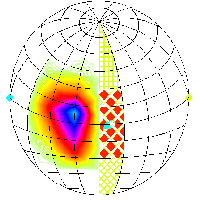|
GEOTAIL
Mission to the magnetotail
The GEOTAIL mission is a collaboration between the Japanese and American
Space Adminstrations to study the dynamics of the Earth's magnetotail from
the near-Earth region (8 Earth radii (Re)) to the distant geomagnetic tail
(about 200 Re). The GEOTAIL spacecraft was designed and built by the
Japanese
and was launched on July 24, 1992. The Institute has contributed the
HEP-LD designed to study plasma dynamics in the geomagnetic tail,
solar flare particle acceleration and propagation, and the origin,
lifetime and propagation of cosmic ray particles.
Science objectives of the Geotail mission
The Geotail mission measures global energy flow and transformation in the
magnetotail to increase understanding of fundamental magnetospheric
processes. This includes the physics of the magnetopause, the plasma
sheet, and reconnection and neutral line formation (i.e., the mechanisms of
input, transport, storage, release and conversion of energy in the
magnetotail). Geotail, together with Wind, Polar, SOHO, and Cluster projects,
constitute a cooperative scientific satellite project designated the
International Solar-Terrestrial Physics (ISTP) program which aims at gaining
improved understanding of the physics of solar terrestrial relations.
The Geotail mission is divided into two phases. During the initial two-year
phase, the orbit apogee was kept on the night side of the Earth by using the
Moon's gravity in a series of double-lunar-swing-by maneuvers that resulted
in the spacecraft spending most of its time in the distant magnetotail
(maximum apogee about 200 Re) with a period varying from one to four months.
In February 1995, phase two was commenced as the apogee was reduced to 30 Re
to study the near-Earth magnetotail processes.
![[Top]](/images/icons/top.gif)
MPS contribution: The Geotail HEP-LD intrument
 The HEP-LD sensor system consists of three identical Imaging
Ion Mass spectrometers which use time-of-flight/energy measurement, and
covers 180 degrees in polar angle over the energy range 10--100 keV for
ENA (Neutral Particles), 30 keV--1.5
MeV for Protons, 80keV--1.5 MeV for
Helium ions, and 160 keV -- 4.0 MeV
for CNO (Oxygen) Ions.
The HEP-LD sensor system consists of three identical Imaging
Ion Mass spectrometers which use time-of-flight/energy measurement, and
covers 180 degrees in polar angle over the energy range 10--100 keV for
ENA (Neutral Particles), 30 keV--1.5
MeV for Protons, 80keV--1.5 MeV for
Helium ions, and 160 keV -- 4.0 MeV
for CNO (Oxygen) Ions.
The instrument is not sensitive to the ionic charge state of nuclear
particles; the mass resolution is marginal for separating carbon,
nitrogen and oxygen ions. HEP-LD provides distribution of
different ions with complete coverage of the unit sphere in phase space.
The Technical Parameters of the HEP-LD
Flight Path S
Deflection Voltage
|
34 mm
0-10 KV
|
Energy Range (KeV)
Hydrogen
Helium
CNO
|
30-1500
80-1500
160-4000
|
Angular Coverage:
polar
azimuthal
|
180/12
360/16
|
|
ENA (KeV)
|
10-100 |
Geomatric Factor
total/differential
|
0.24/0.02
|
![[Top]](/images/icons/top.gif)
Science objectives of the Geotail HEP-LD
By using the HEP-LD data sets, the following scientific objectives
are investigating:
- Particles dynamics in the geomagnetic tail
- CIR, CME and other Solar events related geomagnetic activity
-
Oxygen ion as a "Tracer Ions" in the substorm dynamical process
-
The acceleration process of energetic ion in upstream and downstream
of the bow shock

The classic picture of substorm
The classic picture of substorm and plasmoids formation assumes the
existence of an X line (NENL) tailward of the dipolarization region and
earthward of the thinning region where the Bz component is essentially
nullified. Eventually, part of the plasma sheet is pinched off as a plasmoid,
the residual plasma sheet snaps back towards Earth injecting energetic
plasma into the inner magnetosphere.

An Energetic Oxygen Beam was observed by HEP-LD
HEP-LD instrument is an advanced energetic particle spectrometer with
time-of-flight(T) and energy(E) detection ystems which determine the mass
of incident nuclear particles. The novel design of the sensor head as a
'projection' camera allows the linear imaging of particle distributions
in the polar angle: 12 contiguous angular intervals over a range of 180
degrees. Combined with the sectored spin plane of the unit sphere in the
phase space is covered with a total of 192 contigous angular pixels.
The oxygen ions were flowing tailward in a highly collimated beam.
![[Top]](/images/icons/top.gif)
Related links
|
